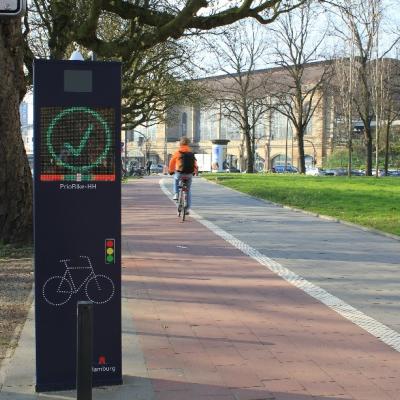Cooperative Intelligent Transport Systems (C-ITS) have so far been almost exclusively focused on motor vehicle traffic, including trucks. C-ITS applications for cyclists are scarcely found, with only a few exceptions. In this article, we explore where C-ITS is already applied for cyclists, where opportunities lie, but also which challenges still need to be overcome.
By Ronald Jorna (MOVECO advies) and Veronique Rietman (Mobycon)
What is C-ITS?
The interaction between vehicles and between vehicles and infrastructure is the domain of Cooperative Intelligent Transport Systems (C-ITS), enabling road users and traffic managers to exchange and use information in a trusted ecosystem to coordinate their actions. This collaborative element—made possible by digital connectivity between vehicles and between vehicles and transport infrastructure—is expected to significantly improve traffic safety, efficiency, and driving comfort by helping drivers make the right decisions and adapt to traffic conditions.
The (potential) benefits of C-ITS for cyclists lie mainly in improved traffic safety, time savings, and convenience. Examples include warnings for hazardous situations, traffic lights turning green earlier, or easier access to (guarded) bicycle parking facilities.
Existing C-ITS Applications for Cyclists
The most well-known C-ITS-like application for cyclists is probably the Schwung app, which allows cyclists to get a green light earlier at traffic lights. This so-called ‘Traffic Light Prioritisation’ is already applied in various cities in the Netherlands. In Zwolle, as part of the BITS project, bike couriers were given priority at several traffic lights using this app. Other applications at intelligent traffic lights (iVRIs) include ‘Signal Phase and Timing Information’ and ‘Green Light Optimal Speed Advisory’, where cyclists receive information on the optimal speed to cycle through green lights. MegaBITS partner Hanseatic City of Hamburg uses this at several traffic lights. These C-ITS applications reduce cyclists' waiting times, saving travel time and increasing convenience. They can also help reduce red-light violations.
Other existing C-ITS-like applications for cyclists include ‘Floating Bike Data Collection’ and ‘Event Data Collection’. Various cycling apps track cyclists (position, speed, direction), such as Strava and Komoot, as well as Google Maps and most bike-sharing systems. Additionally, C-ITS applications can collect additional data, such as Snuffelfiets (air quality) and See.Sense (acceleration, deceleration, road surface quality).
Future C-ITS Applications for Cyclists?
The C-Roads Platform recently released a new version providing a clear overview of all C-ITS use cases, mainly aimed at motor vehicle traffic. A brief analysis shows which use cases could be relevant for cyclists.
Most potential applications relate to traffic safety. Last year, CONEBI dedicated a white paper to this topic. Various applications could warn cyclists of dangers, such as hazardous weather conditions, obstacles on the road, emergency vehicles, or railway crossings. These warnings can prevent accidents.
Additionally, some use cases can increase convenience. Information on road closures enables cyclists to choose alternative routes in time. Apps, like for motorists, could provide cyclists with information about available parking facilities.
The table at the bottom of this article contains a more in-depth analysis of possible C-ITS applications for cyclists. Most of the listed applications are not yet a reality.
Challenges for C-ITS Applications for Cyclists
Before C-ITS is widely implemented in the cycling domain, several challenges must be tackled:
- Standardisation. If you want to receive warnings, they must work everywhere, not just in your own city or country. Currently, if you want to cycle through Hanseatic cities such as Antwerp, Zwolle, and Hamburg (all three partners in MegaBITS), you need a different Traffic Light Prioritisation app for each city (Sway, Schwung, and PrioBike, respectively). While not a major issue, for safety-critical applications, standardisation is essential. Standardisation is also crucial for manufacturers, who can achieve cost benefits and expand their market. The C-Roads Platform is working on establishing C-ITS specifications and plans to give more attention to urban C-ITS applications, such as public transport and cycling, but this is still in its early stages.
- Human Machine Interface. Besides standardisation, C-ITS for cyclists presents an additional problem compared to cars. How can information be conveyed safely to the cyclist? Some applications, like Green Light Prioritisation, work in the background, so the smartphone can stay in your pocket. However, for information on bicycle parking or road closures, a display is almost unavoidable, although acoustic signals and vibrations in handlebars are being explored as possible Human Machine Interfaces (HMI).
- Critical Mass. C-ITS services benefit from mass adoption. The more users, the greater the benefits, such as improved traffic safety and convenience. This requires not only sufficient connected bikes, vehicles, and infrastructure but also user acceptance. Trust, safety, and privacy are crucial. Additionally, relevant data, such as road closures and asphalt conditions, must be available. Without this data, the added value of C-ITS remains limited.
Finally, the question arises whether cyclists even want this. With the rise of e-bikes and speed pedelecs, the value of bicycles increases, and bikes will increasingly be connected, as shown by brands like Boreal Bikes and Cowboy. Safety is important, but part of cycling enjoyment comes from the feeling of freedom. Not everyone wants to be connected all the time.
Conclusion
C-ITS can improve traffic safety and convenience for cyclists. There are already some applications, such as smart traffic lights and route information, but broader implementation still requires standards, a user-friendly interface, and a critical mass of users. Cyclists value freedom, which could influence the acceptance of C-ITS. The future will reveal to what extent C-ITS for cyclists will become a reality.
In the MegaBITS project, various smart cycling solutions are demonstrated. The Province of Overijssel is the lead partner and, together with the cities of Zwolle and Enschede, forms one of five implementation regions. The project runs until 2026 and is funded through the Interreg North Sea programme.
You can find this article in original language (Dutch) on Mobiliteits Platform, here.


